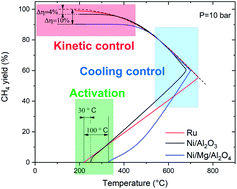当前位置:
X-MOL 学术
›
Sustain. Energy Fuels
›
论文详情
Our official English website, www.x-mol.net, welcomes your
feedback! (Note: you will need to create a separate account there.)
A model-based comparison of Ru and Ni catalysts for the Sabatier reaction
Sustainable Energy & Fuels ( IF 5.0 ) Pub Date : 2019/12/26 , DOI: 10.1039/c9se00787c Emanuele Moioli 1, 2, 3, 4, 5 , Andreas Züttel 1, 2, 3, 4, 5
Sustainable Energy & Fuels ( IF 5.0 ) Pub Date : 2019/12/26 , DOI: 10.1039/c9se00787c Emanuele Moioli 1, 2, 3, 4, 5 , Andreas Züttel 1, 2, 3, 4, 5
Affiliation

|
The differences between Ru- and Ni-based catalysts for the Sabatier reactor are assessed on the basis of appropriate kinetic models and reactor designs. The origin of the higher performance of the Ru-based catalyst is analysed in detail. Ru activates the reactor and initiates the thermal runaway at about 100 °C lower than commercial Ni/Mg/Al2O3 catalysts and 10–20 °C lower than Ni/Al2O3 catalysts. In addition, the higher catalytic activity at low temperature of Ru-based catalysts allows the thermodynamic curve to be followed-up to the region of high CO2 conversion. Over steam reforming Ni catalysts, the highest attainable conversion is instead limited to 90%, while tailored Ni catalysts for CO2 methanation can reach 96% conversion in a single pass reactor. In the intermediate conversion areas, the two catalysts show comparable activity, due to the reaction limitations related to the required cooling and to the diffusional limitations that are more pronounced in the highly active Ru. We developed a reactor design routine to define the amount of catalyst required to reach grid-compatible CO2 conversion, and found that 99.5% conversion is attainable in a single step with a 0.5% Ru/Al2O3 catalyst or with a high load of Ni/Al2O3 by introducing an intermediate water condensation step. As a consequence, we calculated that the cost of the catalyst is approximately two to three times higher for the Ru-based reactor than the Ni-based. However, this difference in catalyst cost cannot compensate for the cost of a more complex system, including several different units, when developing energy storage solutions at a small-scale. For this reason, the Ru-based system is, at the current price and technological state, the most economical solution for small-scale applications, while efficient Ni-based catalysts can be the ideal choice for large scale applications.
中文翻译:

基于模型的Ru和Ni催化剂在Sabatier反应中的比较
在适当的动力学模型和反应器设计的基础上,评估了Sabatier反应器的Ru和Ni基催化剂之间的差异。详细分析了Ru基催化剂更高性能的根源。Ru活化反应器,并在比市售Ni / Mg / Al 2 O 3催化剂低约100°C和比Ni / Al 2 O 3催化剂低10–20°C时引发热失控。另外,Ru-基催化剂在低温下的较高催化活性使得热力学曲线可以追踪到高CO 2转化率的区域。通过蒸汽重整Ni催化剂,可获得的最高转化率限制为90%,而针对CO 2量身定制的Ni催化剂在单程反应器中,甲烷化可达到96%的转化率。在中间转化区中,由于与所需冷却有关的反应限制和在高活性Ru中更为明显的扩散限制,两种催化剂表现出可比的活性。我们开发了一种反应器设计程序来定义达到与网格兼容的CO 2转化所需的催化剂量,发现使用0.5%Ru / Al 2 O 3催化剂或高负荷一步即可达到99.5%的转化率Ni / Al 2 O 3的数量通过引入中间的水冷凝步骤。结果,我们计算出,Ru基反应器的催化剂成本大约是Ni基催化剂的成本的两到三倍。但是,在小规模开发储能解决方案时,催化剂成本的这种差异无法补偿包括多个不同单元的更复杂系统的成本。因此,就目前的价格和技术水平而言,Ru基体系是用于小规模应用的最经济的解决方案,而高效的Ni基催化剂可能是大规模应用的理想选择。
更新日期:2020-03-03
中文翻译:

基于模型的Ru和Ni催化剂在Sabatier反应中的比较
在适当的动力学模型和反应器设计的基础上,评估了Sabatier反应器的Ru和Ni基催化剂之间的差异。详细分析了Ru基催化剂更高性能的根源。Ru活化反应器,并在比市售Ni / Mg / Al 2 O 3催化剂低约100°C和比Ni / Al 2 O 3催化剂低10–20°C时引发热失控。另外,Ru-基催化剂在低温下的较高催化活性使得热力学曲线可以追踪到高CO 2转化率的区域。通过蒸汽重整Ni催化剂,可获得的最高转化率限制为90%,而针对CO 2量身定制的Ni催化剂在单程反应器中,甲烷化可达到96%的转化率。在中间转化区中,由于与所需冷却有关的反应限制和在高活性Ru中更为明显的扩散限制,两种催化剂表现出可比的活性。我们开发了一种反应器设计程序来定义达到与网格兼容的CO 2转化所需的催化剂量,发现使用0.5%Ru / Al 2 O 3催化剂或高负荷一步即可达到99.5%的转化率Ni / Al 2 O 3的数量通过引入中间的水冷凝步骤。结果,我们计算出,Ru基反应器的催化剂成本大约是Ni基催化剂的成本的两到三倍。但是,在小规模开发储能解决方案时,催化剂成本的这种差异无法补偿包括多个不同单元的更复杂系统的成本。因此,就目前的价格和技术水平而言,Ru基体系是用于小规模应用的最经济的解决方案,而高效的Ni基催化剂可能是大规模应用的理想选择。











































 京公网安备 11010802027423号
京公网安备 11010802027423号